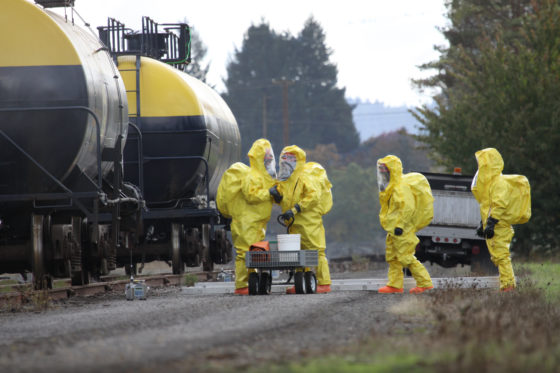What happens when a toxic substance is spilled? A specialized cleanup crew works to contain the hazardous materials. The WISER app can help them stay safe.

Photo credit: iStock.com/BenDC
On November 28, 2017, emergency crews closed the Coquihalla Highway in both directions. A semi-truck had crashed, spilling about 20,000 litres of phenol formaldehyde resin onto the road and into a 40-foot stretch of ditch.
A crew that specializes in these kinds of cleanups was sent in to contain the spill, according to this story in the Merritt Herald.
To find out how workers stay safe doing this kind of work, I contacted Geoff Clark, a senior occupational hygienist with WorkSafeBC.
“These cleanup workers are highly trained specialists who know what they’re doing,” says Geoff, adding that these workers are required to conduct risk assessments and follow exposure control plans before they get anywhere near a toxic chemical spill. Depending on the chemical involved, workers will require different protocols and personal protective equipment.
App gives emergency crews quick access to important information
Geoff says these cleanup specialists are likely using mobile apps to access information and advice. One of these is a free app from the U.S. National Library of Medicine called WISER. It stands for “Wireless Information System for Emergency Responders” and offers users quick and easy access to important information about a hazardous substance.
Geoff and many of his peers see apps like WISER as reliable sources of information about hazardous materials. They’re also good resources for occupational health and safety consultants, people who handle chemicals in warehouses, suppliers of cleaning supplies, and others. Some use this information to supplement safety data sheets.
As we talked, Geoff did a search online for hazardous material reference apps. There were a lot of them! Some free, some for a fee. I asked Geoff how to know which ones to choose.
“Just as with any other app, it’s ‘user beware,’” he says. “Look at the ones that don’t cost you anything.” He adds that governments, universities, and other agencies often offer apps and information free of charge when it’s for the public good, as in the case of WISER.
On that note, here are a few other free apps Geoff thinks would be helpful for emergency crews:
- The 2016 Emergence Response Guideline from Transport Canada helps first responders make decisions during the critical first 30 minutes of a hazmat accident.
- NIOSH offers several mobile apps, including the NIOSH Pocket Guide to Chemical Hazards.
- Health Canada’s Pathogen Safety Data Sheets are available in a mobile app format.
Do you have any apps to suggest? Please let us know in the Comments box below!



ALOHA is a great free app from EPA, USA. It allows a user to predict plume projections for an assortment of chemicals and is integrated with Google maps (Marplot) so can do live response.